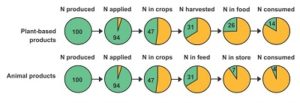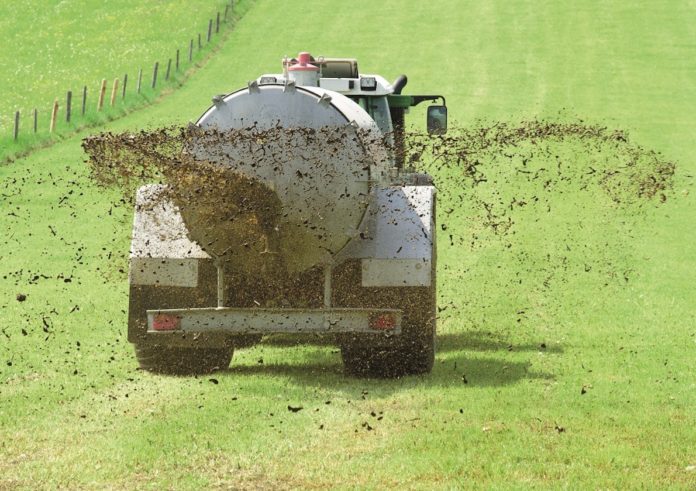The water sector can contribute to progress to a much-needed circular economy. Korneel Rabaey, Ilje Pikaar and Willy Verstraete highlight the needs and opportunities around resource recovery with a rethink of how we satisfy our demand for nitrogen to sustain food production.
Nitrogen is a crucial resource, not least because of its role in relation to food as the key ingredient in producing protein. But its use in agriculture has led to a major imbalance in the global nitrogen cycle. In the agricultural production chain, about 100 million tons of ammonia for use in agriculture is produced annually via the Haber-Bosch process. When used for meat production, only 4% of the reactive nitrogen ends up on the plate. Even a vegetarian diet still only achieves 14% efficiency. One result of this is that today nitrogen is in excess in many places worldwide.
A substantial fraction of the nitrogen ends up in a waste. This portion is then either ‘destroyed’ to form nitrogen gas, or it is discharged into the aquatic environment or atmosphere. The annual costs of pollution by reactive nitrogen from agriculture have been estimated as $210 billion and €320 billion for the US and the EU, respectively.
More efficient ways of using nitrogen in agriculture are needed to enable more sustainable food provision for an expanding and wealthier society, and nitrogen discharges need to be limited and reuse maximised.
Turning waste nitrogen into an opportunity
Household sewage represents a major, if diluted, source of nitrogen. At present, domestic wastewater produces some 20 million tons of reactive nitrogen annually, projected to increase to 35 million tons annually by 2050. The nitrogen in wastewater is typically present as ammonium, and in some cases also as nitrate.
In order to tackle discharge to the aquatic environment, the standard approach is to dissipate this nitrogen content to the atmosphere as inert nitrogen gas. For decades, many wastewater treatment plants have implemented the so-called nitrification/denitrification approach. More energy-efficient processes have been developed, but could we instead focus on nitrogen recovery as input for agriculture?
Getting nitrogen back
An installed capacity of more than 790 million population equivalents exists today at the approximately 30,000 municipal wastewater treatment plants (WWTPs) in the EU. The annual European soy import for protein use is 20 million tons per year, containing 40% protein (eight million tons of protein). If at least 31% of the European WWTPs recovered nitrogen for the production of feed or food protein, this could enable a total protein production of more than eight million tons annually, making the EU independent of external inputs.
Recovered nitrogen can be used to produce food and animal feed by, for example, microbial protein (MP) or algal production systems. The advantages are potentially enormous, such as an unequalled nitrogen-to-protein conversion efficiency, enabling the nitrogen cycle to be improved from 4% to 10% efficiency when used as feed, and up to 43% when used as food. Moreover, the approach is highly productive relative to its footprint. Production rates can be up to 4 kg of cell dry weight per cubic metre of reactor per hour. Conventional meat production, by comparison, requires two hectares of arable land to produce one ton of edible animal protein. In the context of resilience, the production is independent of climate and location as it occurs within a reactor. Water use decreases drastically, by up to 98% relative to current meat production (at the moment approximately 50 m3/kg edible protein).

A project by the Dutch KWR institute calculated that, for Amsterdam, the production of MP from ammonia in WWTP digester digestate alone could cover 36% of the net protein demand of the city’s inhabitants (www.powertoprotein.eu), increasing to more than 100% were all ammonia in the wastewater recovered.
Evidently, MP cannot be used to replace all protein worldwide, but the scale is sufficient to warrant nitrogen recovery. The most common step nowadays is ammonia stripping, particularly on quite concentrated ammonia streams (> 2 g/ litre). The concentration in wastewater (typically 40-50 mg/litre) is low, but wastewater treatment generates sludge. This is converted in anaerobic digestion to biogas, leaving a digestate in which the nitrogen is often sufficiently concentrated. Stripping typically gives an ammonium sulphate solution that can be reused as fertiliser. Other approaches, such as struvite production (a solid containing both ammonia and phosphate), are also being gradually introduced. Source separation of urine at house or building level offers an option to avoid the low concentrations found in wastewater. One example is the Dokken project in Ghent, Belgium, where nutrients from households are recovered as struvite.
Is the future small or large scale?
For source separation, a move closer to households implies adding a more decentralised component to recovery. This may be an economic challenge as resource recovery, particularly in developed countries, needs to compete with industrial, centralised production approaches. For the latter, resource recovery is not a necessity.
For centuries, nitrogen recovery has been used in cities globally by returning human and animal waste to the land. In today’s global sanitation context, developing nations can envisage safer nutrient recovery through small-scale, decentralised technologies that replace direct use of human and animal waste, with this occurring alongside larger-scale centralised technology.
Conventional approaches for economies of scale
However, other typically forgotten aspects need to be factored in, such as the development of local economies. The key is that recovery of any compound must be organised at a level that emphasises quality, local conditions and overall environmental significance. Smaller-scale systems may prove critical to introducing innovation more rapidly within the technology landscape, increasing parallel implementation.
What is stopping us?
The key hurdles are not technological. Society needs to be willing to adopt recovered resources as an essential part of life, even where those return directly or indirectly to the food chain. This implies a societal transition including education that avoids the pitfalls encountered, for example, by water reuse schemes, where there have been cases of considerable public resistance. A legal framework is needed to enable these new categories of feed and food ingredients, as well as new economic frameworks that calculate all the costs associated with a production process, including environmental and societal impacts. This is where legislators need to accelerate, so that the disconnect between technological capability and societal adaptability does not drive future investments back to old concepts and impacts.
Let’s become circular
Throughout history, the foremost role of urban water management has been to safeguard human health and protect the environment. To achieve this, wastewater treatment and engineering practice have always focused strongly on treating water by removing pollutants through dissipative pathways. Approaches such as the activated sludge process have had a major positive impact on our society. While the latter is regarded as one of the greatest engineering achievements of the 20th century, dissipative approaches will not suffice in the 21st-century era of the circular economy where water is a product ‘fit for purpose’.
This implies that urban water management needs to re-envision its role within the circular economy, moving beyond safeguarding human and environmental health to become a more proactive economic force by recovering the resources embedded in urban water. Interventions in the urban and industrial water sector must be closely linked with the agricultural sector, within one overall concept. Since what is essentially re-ordering the disorder present in wastes requires energy, the connection with renewable energy developments will also be essential.
Korneel Rabaey is Full Professor at Ghent University, in the Department of Biotechnology, and a member of CAPTURE. Ilje Pikaar is Senior Lecturer – Environmental Engineering at the School of Civil Engineering, University of Queensland. Willy Verstraete is Emeritus Professor at Ghent University.
A new book and MOOC on resource recovery
Resource recovery from water is becoming an essential part of the circular society, with a wide array of technologies having been successfully demonstrated at lab scale and pilot scale, and several innovative solutions having recently reached full-scale implementation.
A new book published by IWA Publishing (Resource Recovery from Water: Principles and Application, editors K Rabaey et al.) aims to explain the basic principles governing resource recovery from water, to offer a comprehensive overview and critical assessment of the recent innovations in resource recovery from water, and to put resource recovery from water in the correct legal, economic and environmental framework, including the consumerís point of view and environmental impact.
In addition to providing a valuable resource for water practitioners and researchers in the broader IWA community, this book will also serve as a handbook for new and evolving graduate courses and continuing professional development courses in environmental engineering, including a new MOOC (massive open online course) coordinated by Ghent University and expected to be released early in 2020.
See: www.iwapublishing.com/books/9781789060317/resource-recovery-water-principles-and-application
Uniting forces on resource recovery: CAPTURE
A new organisation called CAPTURE (Centre for Advanced Process Technology for Urban Resource recovery, www.capture-resources.be) was founded recently in Belgium. CAPTURE introduces a bottom-up approach, bringing researchers, engineers, companies and government stakeholders together to address new resource recovery developments. These require more effective technology development and the buy-in, from the start, of social scientists to guide the process of introducing new, often controversial concepts into society. With support from the European Union and several Flemish actors, the construction of a new centre to host this platform is due to be completed in July 2020.








